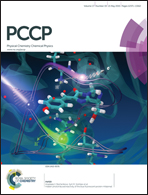Dynamics of aqueous binary glass-formers confined in MCM-41
Abstract
Dielectric permittivity measurements were performed on water solutions of propylene glycol (PG) and propylene glycol monomethyl ether (PGME) confined in 21 Å pores of the silica matrix MCM-41 C10 in wide frequency (10−2–106 Hz) and temperature (130–250 K) ranges. The aim was to elucidate how the formation of large hydrogen bonded structural entities, found in bulk solutions of PGME, was affected by the confined geometry, and to make comparisons with the dynamic behavior of the PG–water system. For all solutions the measurements revealed four almost concentration independent relaxation processes. The intensity of the fastest process is low compared to the other relaxation processes and might be caused by both hydroxyl groups of the pore surfaces and by local motions of water and solute molecules. The second fastest process contains contributions from both the main water relaxation as well as the intrinsic β-relaxation of the solute molecules. The third fastest process is the viscosity related α-relaxation. Its concentration independency is very different compared to the findings for the corresponding bulk systems, particularly for the PGME–water system. The experimental data suggests that the surface interactions induce a micro-phase separation of the two liquids, resulting in a full molecular layer of water molecules coordinating to the hydrophilic hydroxyl groups on the surfaces of the silica pores. This, in turn, increases the geometrical confinement effect for the remaining solution even more and prevents the building up of the same type of larger structural entities in the PGME–water system as in the corresponding bulk solutions. The slowest process is mainly hidden in the high conductivity contribution at low frequencies, but its temperature dependence can be extracted for the PGME–water system. However, its origin is not fully clear, as will be discussed.


 Please wait while we load your content...
Please wait while we load your content...